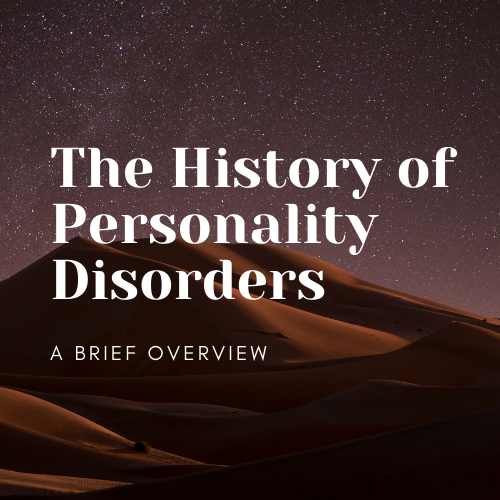The History of Personality Disorders - A Brief Overview
The history of personality disorders can be traced back to 400BC, when Hippocrates described four personality patterns. These were choleric (meaning irritable), melancholic (meaning sad), sanguine (meaning optimistic) and phlegmatic (meaning apathetic). He believed that these patterns were based on the four humors - black bile, yellow bile, blood and phlegm. Hippocrates believed that a person’s personality pattern depended on the level of each of these humors.
Theories of disordered personality can also be traced back to Ancient Chinese and Greek philosophy. Theophrastus (c 371 - c 287 BC) described 30 character types. For example, ‘The Suspicious Man’ has obvious links with today’s Paranoid Personality Disorder.
The category “Manie sans delire” (meaning ‘mania without delusion’) coined by Pinel in the 18th Century appears to describe for the first time what is now known as a personality disorder. He described a set of patients who he thought to behave irrationally despite being in touch with reality. He identified this group as having normal understanding, judgement, memory, perception, etc, but still presenting with unexplainable anger, violence and homicidal behaviour. He suggested that this was caused by a “deficient upbringing” or a “weak and permissive mother”.
The term “moral insanity” has historically been linked with personality disorders. J.C. Pritchard in 1835 suggested this phrase meant “a morbid perversion of the natural feelings, affections, inclinations, temper, habits, moral dispositions and natural impulses without any remarkable disorder of defect of the intellect”.
In the late 19th Century, multiple European psychologists wrote about personality.
Ribot (1839 - 1916) discussed “normal and abnormal characters”, believing these could not be changed. He believed the strength of the traits sensitivity, activity and apathy led to different character types, for example the “humble character” and “contemplative character”.
Kraepelin (1856 - 1926) originally classified “psychopathic personalities” into four types: born criminal, irresolute or weak-willed, pathological liar and pseudoquerulants (meaning paranoid personality). This developed into seven types, including excitable personality, which has links with today’s Borderline Personality Disorder. Kraepelin identified the “emotionally unstable types”, describing this as “those persons who constantly swing back and forth between the two opposite poles of emotion, now shouting with joy to heaven, now grieved to death”. This formed the basis of Borderline Personality Disorder, or Emotionally Unstable Personality Disorder.
Maudsley (1885) linked “moral insanity” to “no capacity for true moral feeling”, “egoistic impulses and desires, to which he yields without check”, and no “evident desire to resist” his motives. Today’s stigma of personality disorders is rooted in historical beliefs.
Then came Freud (1856 - 1939) and the psychoanalytic approach. Instead of believing that supposedly faulty personality was innate, he linked it to childhood experiences. He believed that difficulties in the psychosexual stages such as the oral-biting stage led to distinctive personality traits.
In the 1950’s, those with what are now known as personality disorders were not viewed as being mentally ill, but rather this was viewed as being character flaws and purposeful irrational behaviour. Again, we can see where today’s stigma stems from.
The use of the word “Borderline” stems from a group of patients deemed to be at the borderline between illnesses characterised by psychoses (out of touch with reality) and those characterised by neuroses (mainly anxiety from conflict between the ID, Ego and Superego).
The first Diagnostic and Statistical Manual of Mental Disorders (DSM), published in 1952, officially recognised the category of personality disorders as “patterns of behaviour…resistant to change, but not connected to a lot of anxiety or personal distress on the part of the patient”. This is vastly different from how we understand them today.
The DSM II (1968) described personality disorders as “characterised by deeply ingrained, maladaptive patterns of behaviour that are perceptibly different in quality from psychotic and neurotic symptoms.” It aimed to “include as many clinically useful personality syndromes as could be justified”, despite research not fully validating these. It specified 10 personality disorders - paranoid, cyclothymic, schizoid, explosive, obsessive compulsive, hysterical, asthenic, antisocial and passive-aggressive personality disorder.
The DSM III (1980) defined personality disorders as inflexible, maladaptive and causing significant impairment in functioning or subjective distress. Five new personality disorders were added - schizotypal, narcissistic, borderline, avoidant and dependent, as well as mixed personality disorder.
The definitions and types of personality disorders continued to develop in the fourth and fifth definition of the DSM, to what we have today - paranoid, schizoid, antisocial, borderline, obsessive compulsive, histrionic, schizotypal, narcissistic, avoidant and dependent personality disorder.
Our understanding of personality disorders is still evolving. It is a controversial diagnosis and highly stigmatised, with much of this stigma being rooted in the historic roots of personality disorders.
Sources:
https://www.gulfbend.org/poc/view_doc.php?type=doc&id=478&cn=8
https://www.annualreviews.org/doi/10.1146/annurev-clinpsy-032511-143113
https://onlinelibrary.wiley.com/doi/abs/10.1111/j.1440-1819.1994.tb03033.x
https://www.sciencedirect.com/science/article/pii/S0272735898000026
https://www.sciencedirect.com/science/article/pii/0010440X9390031X
